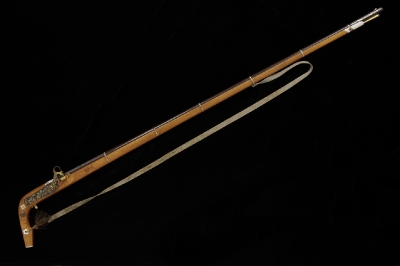114
144
355
98
109
358
104
80
97
66
64
74
102
96
107
348
99
105
82
90
86
116
141
135
143
68
146
332
62
76
83
354
139
77
103
137
142
147
140
63
117
94
125
69
70
92
71
67
78
145
136
128
111
131
343
75
110
106
89
132
88
108
134
118
87
119
100
126
95
122
133
79
382
113
127
85
91
72
130
129
121
65
84
228
229
73
314
315
124
81
120
101
123
138
115
93
385
112
Percussion musket (1884.27.46)
 Close-up showing the hammer of the percussion musketThe distinctive style of Chinese long guns scarcely altered for many years. This 19th-century percussion musket features a stock of similar right-angled shape and decoration to that of Chinese matchlocks made 300 years earlier. The Chinese still used matchlocks alongside flintlock and percussion guns as late as the Second Opium War of 1856–1860.
Close-up showing the hammer of the percussion musketThe distinctive style of Chinese long guns scarcely altered for many years. This 19th-century percussion musket features a stock of similar right-angled shape and decoration to that of Chinese matchlocks made 300 years earlier. The Chinese still used matchlocks alongside flintlock and percussion guns as late as the Second Opium War of 1856–1860.
This gun belonged to a wealthy person as it has ivory mounts and the barrel is inlaid with silver. The four Chinese characters inscribed on the ivory butt translate as ‘metal’, ‘pill’, ‘two’, and ‘one’. This probably told the shooter what size and type of ammunition the gun takes.





